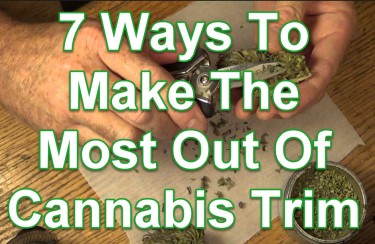
How do you turn cannabis trim into new profits?
Cannabis plants have so much to offer. From processing to packaging, every product and by-product has properties that can be leveraged for better profit. It’s no secret that there is so much money to be made in this industry, but first it’s important to know everything about the business and the product itself.
A lot of time and effort goes into the production and processing of cannabis nuggets. Farmers perform activities such as tending, trimming, and weeding before crops are harvested. Further trimmings are carried out before the products are packed. Everyone in the cannabis industry has their own roles, risks, and skills that are essential to turning plants into profit.
A visit to a cannabis farm will give you an insight into the processes during and after cultivation.
What is cannabis trim?
Cannabis trimmings are often classified as waste because few people know how to use them. More often than not, manufacturers say that the trims are unwanted by-products. However, you are wrong. With a little effort and knowledge, you could turn these unwanted materials into valuable products. A large profit can be made from these materials, so do not be hasty in throwing them away. Use them instead.
Pruning makes a plant—fruit, vegetable, or herb—presentable for sale. All the nuggets you buy in pharmacies, even the veggies and fruits in the stores have been beefed up. Customers will hardly find a freshly pulled plant appealing. No matter how difficult a crop is to grow, harvest and process for sale, it will be pruned. The trimming process is a major factor that determines the value of your nuggets. A lousy disguise deters buyers.
The valuable trimmings mentioned in this article are those that are cut off after harvest. These ingredients include kief, trichomes, sugar leaves, fan leaves, and tiny bits of bud. Offcuts are usually referred to as “waste” because they are low in cannabinoids. Farmers explain that these excess plant materials need to be removed to reduce the plant’s moisture content and give it a unique form for marketing. They are inferior materials and not as strong as buds.
The extraction process
Cannabis trim contains varying amounts of cannabinoids, terpenes, and plant nutrients. The sugar leaves and fan leaves contain a decent amount of cannabinoids, while the water leaves contain various terpenes and phytonutrients.
There are several ways to extract THC and other compounds from the cuts. Some involve the use of an open and closed loop solvent such as propane; others use dry ice, CO2, alcohol, or ice water extraction systems.
Caution should be exercised when using an open loop system as exploration may occur depending on the level of contamination in the trimmings. The safest systems cost a lot to run. For example, a safe closed circuit extractor costs up to $100,000 or more. To determine the best method for your operation, you need to research the amount of cannabis trim available and the best extractor that best suits the materials.
It takes a closed circuit extractor at least a day to fully extract 20 pounds of trim of their beneficial compounds – be careful by sticking to the recommended loading amount. Using an alcohol or water distillation method could take up to nine days for the same amount of trim.
The valuable extract
The product obtained from the extractors is like a sticky liquid. Next, lay it out on wax paper in different pan sizes to make wax or honeycomb. This wax is eggshell colored when dry and crumbles easily.
To make the product appear larger, you can quickly stir or whip the extract for a few minutes before placing it on the paper.
The purest extracts are obtained from solvent-based extraction systems. These products usually have higher levels of CBD or THC, as well as significant amounts of terpenes. The best delivery system for this product is vaporization. On the other hand, extracted products from non-solvent systems are sold as kief mud, also known as bubble hash. They are often darker in color but still have decent THC levels. Some prefer these products over solvent-based products due to their distinct hash flavor.
Other important information
Before attempting to smoke or vape the extract, there must be a set time for it to solidify. Within this time, the excess gases are released in the solvent, water or alcohol used. It is best to wait at least 36 hours for the new product to set before consuming it. Health risks that can result from ignoring this advice include cancer, throat damage, lung disease, and other injuries that can result from dab rig explosions.
Among the possible products, wax is the least durable. If left too long it will become drier and more difficult to work with. Remarkably light and easily crumbled, the waxes can also be difficult to handle, and many valuable crumbs are lost in the process.
Shatter is the most consistent and valuable concentrate. That doesn’t excuse it becoming less stable over time as well. Depending on how long it’s aged, it can be either hard or chewy.
Other uses for cannabis trims
Not everyone prefers to extract the valuable compounds and nutritious juices of these materials to make kiefs, rosin, oils or hash. Cannabis waste can also be used to make edibles, herbs, ointments or creams and compost.
Conclusion
Cannabis trim is like tiny parts of a cannabis plant and as such has similar properties and compounds. The only problem is that the valuable compounds are in limited amounts and less pleasant to smoke.
You can get high from your cannabis waste provided it is cured or extracted the right way. If you are unsure how to store your cannabis trimmings until you are ready to extract them, consider freezing them or storing them in a cool, dark, dry place in your home.
Do not forget; You could make a lot of profit by converting these buds into valuable and presentable by-products.
WHAT CAN YOU DO WITH CANNABIS TRIM, READ MORE…

MAKE THE MOST OF CANNABIS TRIM, HERE ARE SOME IDEAS!
OR..

WET OR DRY TRIMMING, WHAT IS THE BEST WAY TO TRIM YOUR PLANTS?

Post a comment: